How to Start
Reversing Chronic
Absenteeism in
Your District
Including Downloadable Tools and Resources to Get You Started
U.S. schools face a chronic absenteeism crisis, impacting student success. Discover effective strategies and tools to improve attendance and academic outcomes.

Table of Contents
Pandemic Challenges Continue to Impact Chronic Absenteeism
How Districts Are Successfully Improving Attendance Rates
8 Ways to Get More Kids to Class
1. Prioritize Attendance Tracking and Data
>>> Download the School Attendance Tracker Template
2. Cultivate an Attendance-Focused School Culture
>>> Download the Letter from the Superintendent Template
3. Utilize Preventative Messaging and Positive Reinforcement
>>> Get the Attendance Postcard Template
4. Initiate Early Intervention for the Moderately Chronically Absent
>>> Download the Attendance Contract Template
5. Pursue Intensive Intervention for the Severely Chronically Absent
6. Establish Clear Attendance Teams and Accountabilities
7. Leverage Positive Reinforcement School-Wide
8. Track Metrics and Monitor Progress
Success Story: How Prince William County Improved Attendance in 100+ Public Schools
Chronic absenteeism has reached epidemic levels across U.S. schools, severely impacting academic performance and long-term student success. Case in point: according to the White House, for 4th graders, absenteeism alone is responsible for a 27% decline in math scores and a 45% drop in reading scores on the Nation’s Report Card.
With one in three students now missing at least 10% of the school year—a crisis-level statistic—districts need to adopt a proactive, “all hands on deck” approach to have a lasting impact on attendance. The traditional reactive, punitive methods of targeting only the most severely absent students have proven ineffective and risk further disengaging families. What’s needed is a comprehensive strategy emphasizing preventative measures and positive engagement with all families.
In this playbook, we’ll look at national attendance trends based on sources from FutureEd, Return to Learn, and The New York Times, compared with a sampling of 118 districts representing almost a million K-12 students that employ proactive, positive attendance management strategies and tools through SchoolStatus Attend.
Looking at trends pre-pandemic compared with year-over-year statistics from the past three years provides an illuminating, though concerning, picture of chronic absenteeism trends across the U.S. However, top-performing districts show that there are specific, repeatable steps schools and districts can take to start reversing these trends and dramatically improving student outcomes.
By combining data-driven targeted interventions with inclusive, ongoing communication to all families, leading districts have achieved unparalleled results. Read on for downloadable resources that you can start using immediately.
Read on for downloadable resources that you can start using immediately!

Pandemic Challenges Continue to Impact Chronic Absenteeism
Publically reported state attendance data shows that chronic absenteeism remained steady at 15% for the two academic years immediately preceding the COVID-19 pandemic. Data for the 2019-2020 and 2020-21 school years is considered less reliable due to challenges in reporting remote attendance. In 2021-22, chronic absenteeism almost doubled compared to pre-pandemic levels, with a national average of 28%.
In the 2022-23 school year, over 26% of students were chronically absent across 41 states and approximately 80% of the nation’s student population. While this is slightly lower than the previous year, the rate is still alarmingly high compared to the years preceding the pandemic.
One Size Never Fits All
Attendance can vary drastically between states, districts, grades, and ethnicity groups. Looking at state-reported data, New Jersey reported the lowest chronic absenteeism rate at 16.6% while Alaska rose as high as 45%. In the SchoolStatus data set, high schools reported an average 31% chronic rate, higher than any other grade band. And in urban districts like Washington D.C., chronic absenteeism rates soared above 43%.
Chronic Absenteeism by District Size
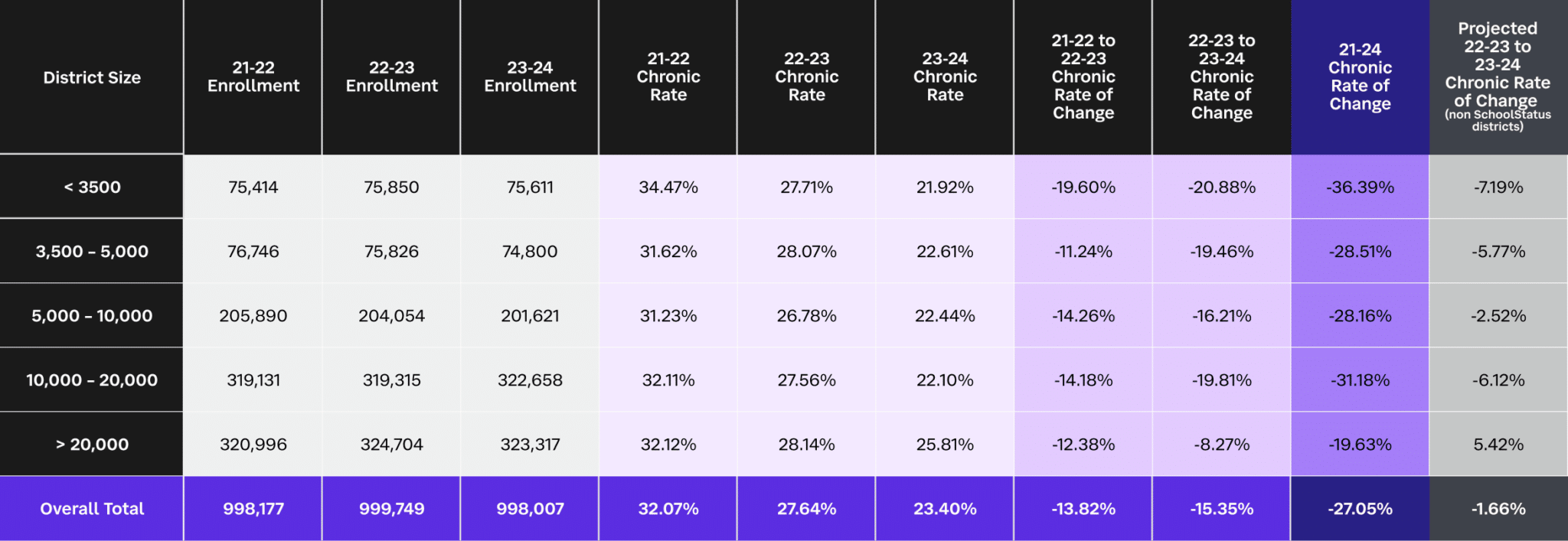
Client Chronic Absenteeism Data vs National Chronic Absenteeism Data
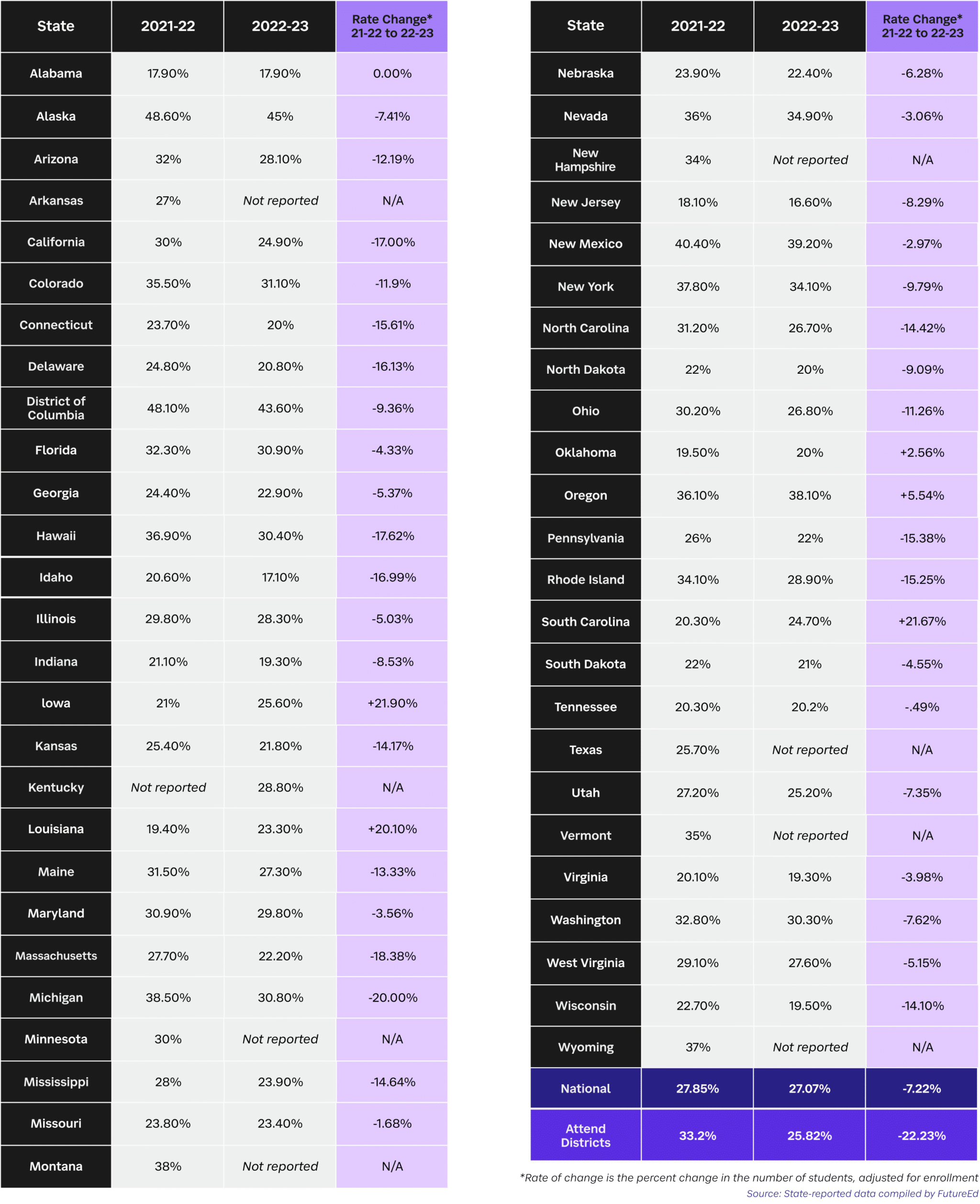
Examining the SchoolStatus data by student race/ethnicity reveals some of the most glaring disparities. Students identifying as Black (30.1%), Hispanic/Latinx (25.72%), Native American (32.84%), and Pacific Islander (32.47%) had chronic absenteeism rates of 25% or higher. In contrast, Asian students had a remarkably lower 10.49% chronic absence rate while white students were at 18.36%.
Chronic Absenteeism by Student Ethnicity

How Districts Are Successfully Improving Attendance Rates
Districts that are seeing improvements in their attendance rates have shifted towards an equity-based attendance management approach that emphasizes:
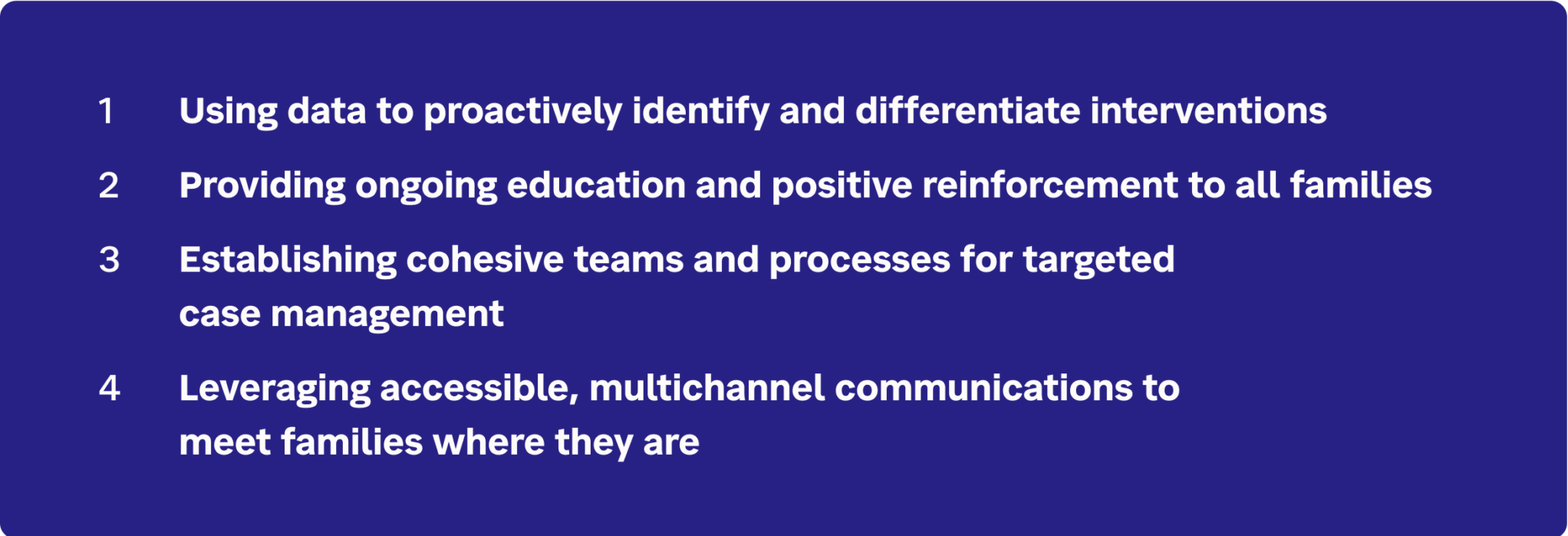
While national chronic absenteeism rates only improved by 8.54% from 2021-22 to 2022-23, looking at proprietary data from close to a million students in partner districts, SchoolStatus found that districts using this approach achieved more significant progress over that same timeframe:
- SchoolStatus partner districts reduced chronic absenteeism by 22% from 2021-22 to 2022-23
- Elementary school reductions were the highest, ranging from 27.82% in PreK-3rd grade to 23.45% in grades 4-6, setting these young students up for better attendance and higher academic achievement throughout their academic journeys
By leveraging their comprehensive attendance tracking and intervention systems, SchoolStatus districts outpaced national improvement rates by over 260% from 2021-22 to 2022-23. Their data illuminates what’s possible when taking a systemic approach to proactive engagement and addressing root causes.
By taking this comprehensive proactive and inclusive approach, SchoolStatus Attend customers have experienced 54% of at-risk students returning to school after initial proactive contact, up to 75% reductions in time spent by staff on attendance notifications, and increased family trust and engagement.
While a systemized, district-wide approach has the greatest impact, there are plenty of tools schools and districts can implement on their own. Try one or all of these strategies using the tools below.
8 Ways to Get More Kids to Class
While the equity-based methodology represents an overarching philosophy, incorporating the following eight best practices enables districts to operationalize the approach to achieve results across grade levels, school sizes, and student demographics.
1. Prioritize Attendance Tracking and Data
The Practice: Implement accurate daily attendance tracking, including partial absences and reasons for absence. Analyze data regularly to identify at-risk students before they become chronically absent.
How to Implement: Train all staff on proper attendance-taking procedures and use a system that captures nuanced attendance data beyond just present/absent coding. Set up processes and designate specific staff to review attendance data reports weekly or bi-weekly to flag concerning patterns or students missing too many days.
Potential Barriers: One of the biggest challenges is ensuring consistent attendance-taking practices across all teachers and classrooms. Provide very clear guidance, consider observation audits, and hold staff accountable for accurate practices.
2. Cultivate an Attendance-Focused School Culture
The Practice: Prioritize attendance messaging and visibility in all communications—from the district level down to each school and classroom. Embed attendance into core procedures, policies, professional development, and everything the school does. Celebrate good and improved attendance to make being present feel “cool” and expected.
How to Implement: Audit all existing communications, procedures, and policies to ensure attendance is embedded appropriately with clear, consistent expectations and visibility. Add attendance components to staff professional development, student orientations, parent meetings, open house nights, etc. Implement school-wide public celebrations, postings, and shout-outs for students with perfect or improved attendance.
Potential Barriers: Low school connectedness and students lacking motivation or reasons to feel engaged in the school community can severely undermine attendance efforts. Prioritize building an atmosphere of representation and belonging so all students feel respected and inspired to actively participate in their learning community. Increase student buy-in by giving them a voice in designing the school experience, implementing student feedback, and highlighting the rich extracurricular opportunities missed when absent.
3. Utilize Preventative Messaging and Positive Reinforcement
The Practice: Send universal proactive communications to all families spelling out the district’s attendance policies and the importance of daily attendance for academic success. Mail and email this correspondence in families’ home languages at least once each semester—more frequent communication leads to higher attendance in the vast majority of schools studied. Center communications on positive messaging, sharing the benefits of attendance both for student success and better long-term life outcomes.
How to Implement: Don’t wait until students have already missed significant time in school before communicating. Be proactive before Day 1. Leverage email, text, automated calls, and mail capabilities—along with translation services—to share important attendance information in families’ preferred languages. The most impactful content combines educating families on the importance of attendance with celebrating attendance wins. Get creative with visuals, graphics, and incentives like prize drawings or interclass competitions to increase engagement.
Potential Barriers: Even with multichannel efforts, getting families to consistently read, understand, and absorb the attendance messaging can be difficult. Consider higher-touch printed mailings, robocalls, 2-way messaging, and eye-catching visuals to grab their attention. Offering translation into each family’s preferred language is another way to both improve attendance and build trust and engagement in school communities.
4. Initiate Early Intervention for the Moderately Chronically Absent
The Practice: For students exhibiting the beginnings of a pattern of absenteeism, intervene with targeted personalized outreach before their situation escalates further. This could include calls home, text messages, letters, meetings with parents and guardians, attendance contracts, and continued positive reinforcement about the importance of showing up to class.
How to Implement: Utilize automated multichannel communication capabilities to streamline interventions at this important stage. Enable designated staff to easily send customized calls, texts, emails, and letters without manual effort. Pair digital outreach with in-person conferences where staff meet one-on-one with families, create attendance contracts, and provide positive encouragement about getting their students’ attendance back on track. Families want to know before it’s too late to help.
Potential Barriers: Handling the volume of moderately chronically absent cases and having enough staff capacity to execute interventions can be an obstacle, especially for larger districts. Develop intervention templates staff can use for frequently standardized situations. Go even further and implement tools to save staff time and translate communications into recipients’ home languages.
5. Pursue Intensive Intervention for the Severely Chronically Absent
The Practice: When students miss 10% or more of instructional time, treat it as an urgent priority. Leverage all available resources and staff including counselors, social workers, mentors, and community partners to initiate more intensive interventions. Analyze attendance data by grade, school, and class to identify patterns that could indicate root causes, such as providing transportation assistance.
How to Implement: With severe chronic absence, more intensive and escalated actions are required beyond just letters and calls. Staff should initiate home visits, intensive customized case management, and coordinate with community partners to provide potential wrap-around services for the student and family. Always analyze the attendance data for the student to identify if there are patterns or root causes, like transportation or internet connectivity issues, that could be addressed more systemically.

Potential Barriers: A common challenge for severely chronically absent students is that families are unresponsive or unwilling to engage with the intervention efforts, despite schools attempting multiple outreach methods. Develop protocols for extensively documenting all communication attempts, which may be needed to eventually explore compliance procedures.
6. Establish Clear Attendance Teams and Accountabilities
The Practice: Define clear roles, responsibilities, and processes for monitoring attendance data, executing intervention strategies, managing student caseloads, and tracking metrics. Nominate an attendance coordinator or leader. Set visible goals and frequently review progress to measure the success of initiatives and strategies.
How to Implement: Develop a cross-functional attendance team with representatives from administration, teaching, counseling, etc. Clearly delineate roles like who is responsible for data monitoring versus executing interventions versus managing individual student cases. Nominate one primary attendance coordinator or leader. Establish protocols and processes that are documented and sustainable year-over-year. Set benchmarks for improving chronic absenteeism rates and review metrics frequently.

Potential Barriers: A common obstacle is siloed departments or a lack of coordination and collaboration on attendance issues at school or district levels. Make it explicit that attendance requires a cohesive team effort with shared accountability. Emphasize why developing relationships and partnerships between all the key stakeholders—administrators, staff, counselors, teachers, and family members—supports student success in the short- and long-term.
7. Leverage Positive Reinforcement School-Wide
The Practice: Implement comprehensive systems for proactively encouraging, incentivizing, and celebrating exemplary results and attendance improvement school-wide. This includes tangible rewards, visible displays and recognition, as well as engaging activities like contests and competitions between classrooms.
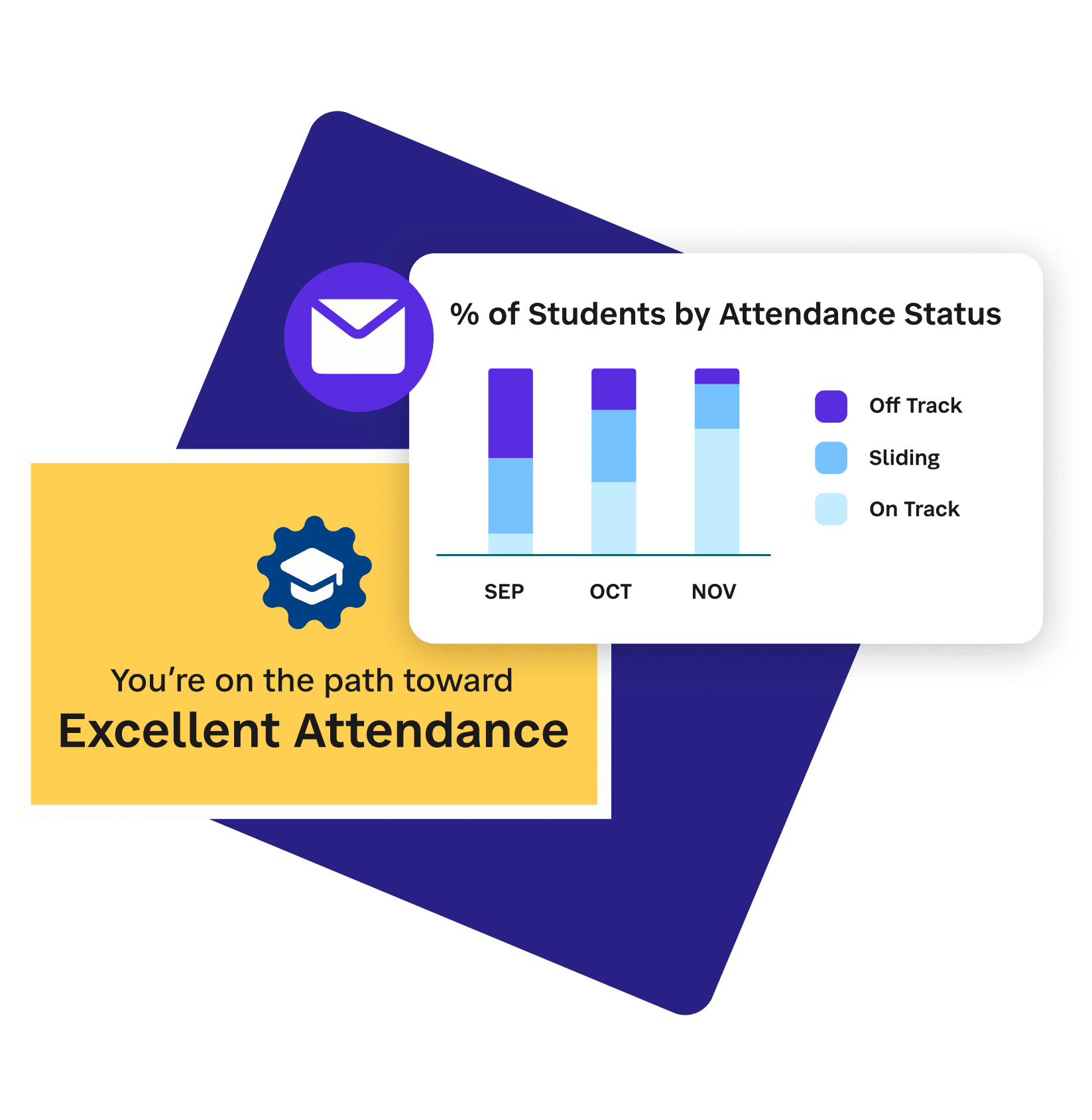
How to Implement: Develop appealing tangible rewards and privileges that students will get excited about, such as gift cards, parties, fun activities or experiences. Create visually prominent attendance “Hall of Fame” displays and leaderboards that are updated frequently. Facilitate attendance contests and competitions between classes or grade levels, with prizes like extra recess time or pizza parties for the winners.
Potential Barriers: Consistently implementing and sustaining these positive reinforcement programs across every school and classroom can be difficult without full buy-in from all teachers and staff. Increase participation by sourcing student input and engaging them in designing the initiatives, leveraging student attendance champions. Expand efforts and reward schools, Principals, and attendance officers with award certificates and recognition in a district newsletter, on social media, or on the website.
8. Track Metrics and Monitor Progress
The Practice: Generate detailed reports on chronic absenteeism rates and other attendance metrics, analyzed by different student demographics, grade levels, schools, etc. Continually evaluate progress against goals and benchmark time periods to see the impact of initiatives. Use that data to make adjustments to strategies and resource allocation based on the trends identified by the attendance team.
How to Implement: Invest in robust attendance tracking and analytics capabilities to access the reporting needed. On a monthly or quarterly basis, generate reports that scrutinize chronic absenteeism rates through different lenses like by racial/ethnic groups, economically disadvantaged students, language proficiency, etc. Compare rates to previous years and interim periods to identify any wins or areas still struggling. Use these insights to adapt intervention approaches, explore root causes, and reallocate resources accordingly.
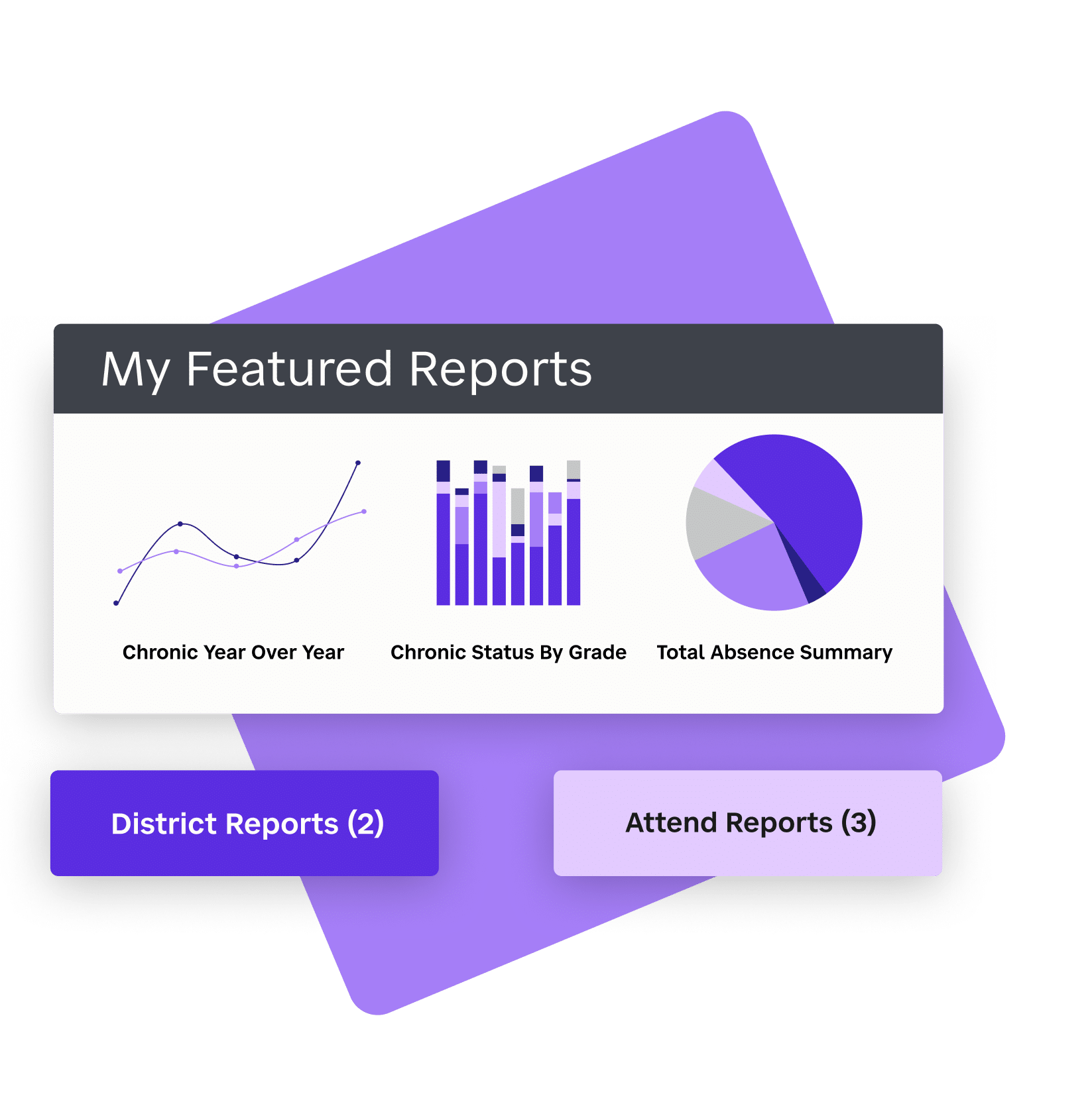
Potential Barriers: Relying on cumbersome manual attendance processes for data collection and analysis makes it extremely difficult to effectively track, measure, and adjust attendance efforts. Having quality data that is digestible and actionable is crucial for monitoring and adjusting your attendance outreach and intervention strategies.

Success Story: How Prince William County Improved Attendance in 100+ Public Schools
Prince William County Public Schools (PWCS) faced severe attendance challenges for their 92,000+ student population, with some schools seeing chronic rates as high as 40%, especially among Hispanic and low-income students. Recognizing that their internal efforts weren’t making enough of an impact, they sought a partner to equip educators and staff with effective tools for school-home communication and attendance interventions.
PWCS implemented SchoolStatus Attend partway through the school year, coinciding with new Virginia policies that increased the stakes around attendance tracking and accountability.

Based on their commitment to addressing digital equity, narrowing the homework gap, and ensuring that all students have the opportunity to achieve their full potential, the district received the 2024 Community Leadership Award for Digital Equity by the Consortium for School Networking (CoSN).
SchoolStatus Attend allows us to use data to target and communicate directly with at-risk families about attendance in their language. For too long we just sent the same newsletter home with no true engagement.”—Chief Information OfficerLarge School Division
By taking a proactive, data-driven approach powered by the SchoolStatus Attend platform and implementation team, PWCS made significant strides in getting more students to school every day.
SchoolStatus Attend Streamlines and Automates These Best Practices
While the eight tactics shared here have been proven to make a noticeable impact for districts of many sizes and demographics, executing this type of comprehensive approach requires significant time, energy, and resources.
SchoolStatus Attend supports districts’ attendance management by streamlining and automating the process for districts by providing:
- Accurate attendance tracking integrated with your SIS, including partial absences and learning time
- Analytics dashboards highlighting at-risk student caseloads by grade, school, class, and demographic group
- Automated digital and direct mail multi-channel messaging and communications, translated into families’ home languages
- Digital attendance documentation and customizable intervention workflows
- Proactive education about the importance of attendance
- Ongoing positive reinforcement tools like attendance competitions and student recognition
- Robust reporting on attendance metrics to track progress against goals and see the impact of your efforts each semester and year
By centralizing these capabilities into one unified solution, SchoolStatus Attend enables districts to efficiently coordinate equitable, proactive attendance management.
The Path to Student Success
The chronic absenteeism crisis poses immense consequences for student achievement and long-term success across our nation. However, evidence proves it is possible to reverse entrenched attendance challenges within a single school year through comprehensive, equity-based attendance management practices.
By prioritizing data, executing differentiated interventions, providing proactive family engagement, establishing processes and ownership, incentivizing good attendance, and cultivating a supportive culture, districts can dramatically reduce chronic absenteeism rates—especially by leveraging tools that streamline processes and ensure communication is accessible for all families.
With strong leadership and commitment to proven best practices, we can ensure every student has the opportunity to attend school consistently, receive a high-quality education, and live the healthy, successful life they deserve.




